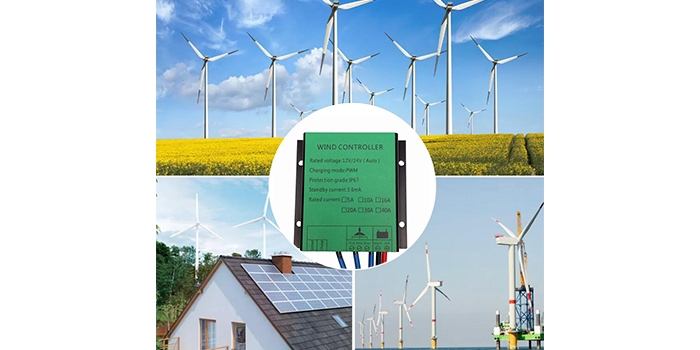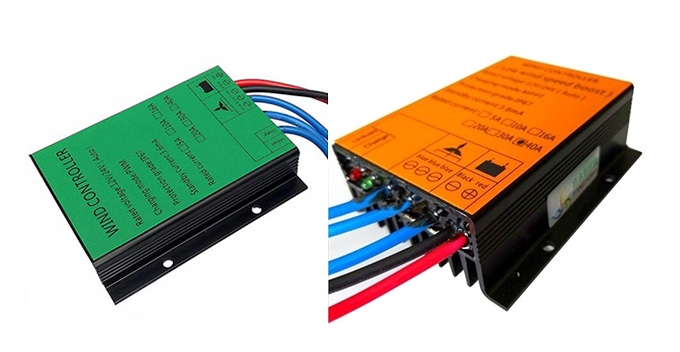A wind turbine charge controller is a critical component in wind power systems, responsible for managing and controlling the electricity generated by wind turbines. It ensures the safe and efficient use of this energy, either for charging batteries or directly powering loads. This blog will explore the working principles, functional features, design concepts, and modern applications of wind turbine charge controllers.
Basic Functions of a Wind Turbine Charge Controller
The primary functions of a wind turbine charge controller include:
- Energy Regulation and Control: The controller regulates the electricity generated by the wind turbine. It directs the adjusted energy to either DC or AC loads, while surplus energy is used to charge batteries according to their characteristic curve.
- Battery Protection: Once the battery is fully charged, the controller prevents overcharging. It also safeguards against over-discharge when the battery's energy is depleted, thereby extending the battery's lifespan.
- Smart Charging Management: The controller uses advanced strategies, such as PWM (Pulse Width Modulation), for seamless load management. It ensures that the battery voltage remains stable at the float charge level while maximizing the use of surplus energy.
- Monitoring and Display: Most controllers come equipped with LCD screens to display real-time battery voltage and charging current, giving users a clear view of the battery’s status.

How Does a Wind Turbine Charge Controller Work?
1. Energy Conversion and Transmission: Wind turbines capture wind energy through blades and convert it into rotational mechanical energy. This mechanical energy is then transferred, often via a gearbox (which may be omitted in direct-drive turbines), to the generator, converting it into electrical energy. The charge controller processes this generated power through initial energy regulation.
2. Energy Distribution: The controller’s core task is to distribute the regulated energy appropriately. When load demand is low, excess energy is directed to charge the battery bank. During the charging process, the controller adjusts the current and voltage based on the battery’s status to prevent overcharging or over-discharging. In times of high load demand, it releases energy from the battery to the load, ensuring system stability.
3. Battery Charging Management: The battery, as a key energy storage device in wind power systems, requires careful management. The controller uses PWM technology for smart battery charging. When the energy generated exceeds the battery’s capacity, the controller gradually unloads the surplus energy, avoiding waste. It also monitors charging voltage and current to ensure a safe and efficient charging process.
4. Monitoring and Protection: Wind turbine charge controllers come with robust monitoring and protection features. They continuously track the operation of the turbine, generator, battery, and loads. If abnormalities occur (e.g., excessive wind speed, generator malfunction, or battery overcharge/discharge), the controller activates protective measures, such as stopping charging or activating the brake, to ensure safe operation.
Design Principles of Wind Turbine Charge Controllers
1. Control Strategies: The control strategy is key to achieving efficient and intelligent charging management. Common strategies include digital intelligent control based on microcontrollers, fuzzy logic-based intelligent control, and neural network-based intelligent control. These methods adjust parameters in real time based on the system's actual operating conditions, optimizing the charging process.
2. Circuit Design: The circuit design of the wind turbine charge controller must account for its operational environment and functional requirements. It should feature strong anti-interference capabilities and stability to ensure proper operation in harsh outdoor environments. Efficiency and cost-effectiveness must also be considered to reduce overall system operating costs.
3. Hardware and Software Integration: The effective operation of a charge controller relies on both hardware and software. The hardware components, including the microcontroller, sensors, and power drive circuits, implement specific control functions and energy conversion. The software manages control strategies, monitoring, and protection. Together, they provide the controller with powerful control and intelligence capabilities.
Applications in Modern Wind Power Systems
As the demand for renewable energy grows worldwide, wind power is widely used as a clean and renewable energy source. Wind turbine charge controllers, as key components, play an irreplaceable role in modern wind power systems.
- Improving System Efficiency
The controller intelligently regulates and controls the wind turbine's generated power to maximize system efficiency. It adjusts the current and voltage based on the battery’s status, ensuring a safe and efficient charging process.
- Reducing Operating Costs
Intelligent charge management minimizes energy waste and loss, thus reducing system operating costs. Additionally, its monitoring and protection functions can promptly detect and resolve system anomalies, reducing downtime and repair costs.
- Enhancing System Reliability
The controller monitors the system in real time and takes protective actions when necessary, ensuring stable operation and enhancing reliability. It can withstand harsh outdoor conditions, consistently providing stable power to the system.

As a critical component in wind power systems, the performance of wind turbine charge controllers directly impacts the system's efficiency and stability. With advances in technology, Inverter Online Shop can expect future controllers to be more efficient, intelligent, and reliable, supporting the sustainable development of wind power systems.
However, the limitations of wind power, such as its dependency on wind resources and adaptation to natural environments, should also be acknowledged. Continued research and improvement are necessary, including enhancing wind turbine efficiency and advancing energy storage technologies, to promote sustainable development. Strengthened international cooperation and knowledge exchange will further drive the global renewable energy sector forward.
